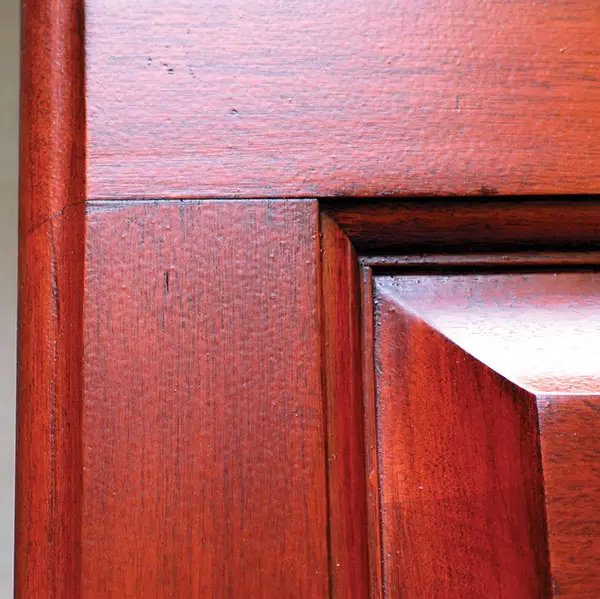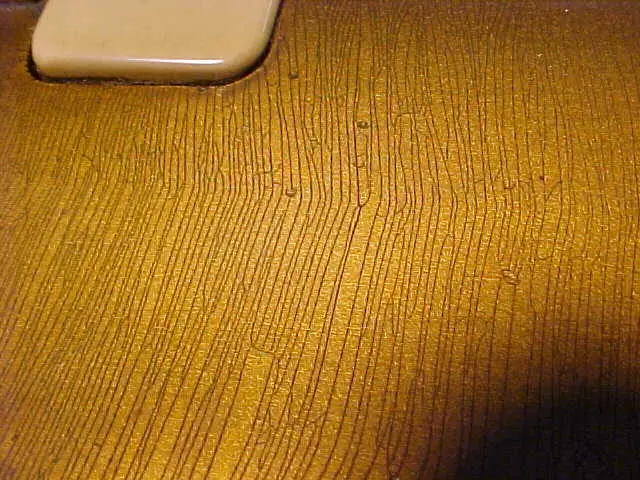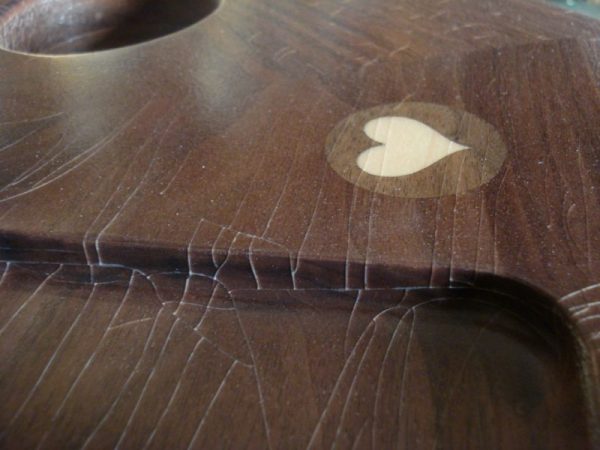The appearance of cracks in the final film is one of the finishing defects that scares everyone. Firstly, because there is no other way to fix it other than sanding it down to the wood and going through the whole process again - which scares the manufacturer - and secondly, because it is blamed on the finishing materials, of course scaring the supplier of such materials. But it is not always the varnishes that are to blame. Most often the cause is a thick coat of varnish, a thick film from a single application or from too many coats on top of each other.

In production there is always a rush to finish products, especially when it comes to finishing. It's basically the last stage, and if there was time for fixes before then, now you have to work fast forward. The customer needed the furniture yesterday, the truck is waiting and there are penalties to be paid and many such reasons that make everything have to be done in a hurry. As a result, even though it is recommended to apply 2-3 coats of primer, with drying and sanding in between, only one coat is applied, as thinned as possible so as not to make spills. And so the drying takes longer and it appears orange peel.

In general, the orange peel-looking primer film is not that annoying because the effect can be removed by sanding. But there are risks. You sand more and, from overzealousness, you end up with wood again. That's all right, we cover with varnish, that's generally the reaction. And you apply a coat of varnish, and another, and another, because varnish has a smaller body (resin) and covers less than primer. In the end, although only one coat of varnish is recommended, 3-4 coats are given to achieve the desired look.
The consequences?
- Much higher cost because the varnish is more expensive than primer,
- Weaker coverage, because the lake is leaner in the body,
- Heavy sanding between coats of varnish because varnish is made not to scratch, so it will resist sanding,
- Too many layers of varnish can eventually lead to cracks in the film.

There is also the option of not applying several coats of varnish, but applying a "good" one, i.e. thick, because good is not good. Applying a very thick coat of varnish also has consequences:
- The thinner does not come completely out of the film. When wrapped in plastic wrap the thinner, which continues to come out, stays on top, re-wets the film and imprints appear from the wrap,
- The risk of the film looking like orange peel,
- The stresses in the thick compact layer lead to cracks in the film.
Accordingly, as I recommend in the title, avoid many coats of varnish or primer, and no single very thick coat. Of course, the worst is to be both many and thick. I told you in an article that you should always read the instructions on how to use the materials: the instructions for use written on the box in the case of DIY products or the product data sheets for industrial products. It always says how many layers of the product are recommended. More layers means cracks in the film. It also says how much of the material is recommended to be applied per coat. More can also lead to cracks.

It is definitely better to apply several thin coats than one thick one. Several meaning 2-4, depending on recommendations. A total film of 500 g/sqm and more is very likely to crack, and if applied to solid wood it will certainly crack with dimensional changes due to moisture variation. In the case of solvent based products, the addition of thinner to the application is very important because it stimulates drying, the material dries faster.
I hope I've managed to convince you that it's better to put the customer off for another day or pay a one-day late penalty on the truck than to have to re-take the finish or worse, have the furniture returned to be refinished.




































Hello,
I follow and appreciate your articles.
I need some advice about painting the exterior woodwork. The pine wood carpentry is painted by the manufacturer with a colored, water-based varnish, the initial finish being semi-gloss, installed 10 years ago. For the first 3 years I protected the exposed exterior with a wax based product which was very effective. Due to carelessness, I discontinued this treatment, and now on the side exposed to the sun the "paint" has started to crack and I have decided to redo the finish.
I started cleaning the moving window (dismantled) by scraping and sanding. I used three grits, 60/120/240. I used a water-based impregnating agent (two coats) and a thick colored varnish from Trilak. I applied the varnish with a sponge roller in very thin coats. The manufacturer specifies a certain amount of varnish per square meter, I applied four coats with intermediate sanding (sponge 180). The color is uniform but I'm not satisfied with the appearance, it's not very glossy and the wood grain was not totally covered (it appears in relief) although I checked the surface after priming and it looked ok. I continued on the fixed window and on the heels, and had an unpleasant surprise. I finished and impregnated similarly, still four coats of varnish, but may have given a thicker coat due to painting "in place" and wanting the wood grain to be covered better, so the shade came out darker than on the movable window. The bigger problem is that when I peeled off the tape that protected the glass, I also peeled the lazure off the wood. I noticed that the lazure didn't "catch" on the wood... Once again I think I gave the layers too bare, the embossed look of the fiber was left. Where did I go wrong, and what to do next? Apply fewer coats?
I was happy with Trilak's thick lacquer, applied with a brush on the shutters (two coats), it came out almost fine, glossy looking, but there were fine streaks left from the brush... so I tried it now with the sponge roller. It has good UV resistance, the shutters have been painted for three years, no other care, they sit in the sun and are ok.
Thanks in advance.
Good morning,
The last sanding of the wood in white was too fine (240) and the wood could not absorb the thick lacquer. Hence the lack of adhesion. However, the sanding of the varnish was too small (180), which resulted in the removal of part of the layer and the final result was a thinner layer with less coverage.
I recommend 150 grit as the last sanding of white wood, and at least 240 grit for sanding between layers.
To increase the adhesion of the first coat of varnish you can thin it a little. Instead of water, you can use the coloured impregnating agent given as a first coat to prevent the wood fibre from lifting too much. This is if the varnish is also water soluble (that's how I figured it out). The dilution should not exceed 10%. As far as I can tell the product is thixotropic (the traces left behind by the brush) and if you add more water you lose this property, the product becomes very fluid, and there is a risk of spillage.
Lack of gloss can be from very thin coats, coarse sanding between coats, but also from varnish - it has low gloss. That's how you bought it, or you didn't mix it well and the matting agent settled to the bottom of the can. So you have different gloss levels from coat to coat, the first being the most glossy and the last, visible, the most matt. You must mix the product well in the packaging before application. Use a rod, stick, or something similar. This way the mixing will be more efficient than simply suturing the can.
I hope I've been useful.
All the best.
Hello,
I have a round wood house and I am going to apply the varnish coats. Can you tell me what kind of varnish to buy and how to apply it? Possibly what brand of product to look for.
I kiss my hands,
I read with great interest your articles and would need your help and guidance for finishing some air purifiers whose housings will be made entirely of solid laminated milled & cnc engraved basswood. How can I get in touch with you?
Yours faithfully
Silviu Măgureanu
AJA Registrars Romania
http://www.ajaromania.net
Hello,
You can write to me at mihaela.radu@cesbrands.ro.
All the best!
Hello,
I want to install pine floor in my house (the plank is about 3 cm) and I would like to ask you what materials I should use (wood stain, varnish stain, primer, varnish,...etc.) and in what order/if any and which layers should be sanded (I would like to specify that I would like to slightly darken the color of the wood and I would like to protect it from scratches and cleaning solutions). Another question would be if the wood should be treated with any solution on the underside as well (against mould or decay).
I inquired at some DIY stores and at a warehouse specializing in wood maintenance/finishing solutions and it seemed to me that everyone was trying to sell the products without fully advising you (nowhere was I told that a very important difference between water-based and solvent-based lacquer/primer, except for price, is that the former lasts longer over time-so it justifies the higher price). For example, I've been told that I can just apply two coats of primer without applying traffic varnish because it's no longer necessary (from what I've read in one of your articles primer doesn't have the same properties as varnish), that it's not necessary to apply multiple coats of primer/varnish or sanding between coats.
Thank you in advance for your kindness and I also congratulate you for the articles you wrote :). All the best.
Good evening.
It would be good if you treated the wood before fitting against insects and mould. There are water-based solutions that can be applied with a brush and after drying you can apply any kind of finish. There is also ready-treated wood, but it is more expensive.
The finishing steps are bait, primer and varnish.The bait is applied to stain the wood and can be solvent or water based. After drying, any kind of finish can be applied on top. Water-based wood stain is odourless, but dries a little harder and lifts the wood grain. Solvent-based wood stain is odorous, but the grain lifts less and sanding is easier.
After the bath has dried, without sanding, the primer is applied. The primer is so made that it adheres well to the substrate, is thick (it has a larger solid body than varnish) and grinds very well. Apply 1-2 coats. After complete drying it is sanded. Sanding is done with 280 or 320 grit sandpaper if the lacquer to be applied is matt and over 400 if it is glossy.
At the end apply the varnish. The varnish is formulated to be hard, scratch and abrasion resistant, aesthetically pleasing (glossy or matte, silky, etc.). In general, only one coat of varnish is applied. If a second coat has to be applied, it is applied without sanding, before the first coat is completely dry (after 30-45 min.). That way it has adhesion to the lower coat. Avoid sanding the varnish because, being made to be scratch resistant, sanding is very difficult.
There are also products made specifically for DIY application that are a kind of primer-lacquer. These can be applied after bathing, 2-3 coats, with sanding in between, without the need for primer.
Floor products can be water-based or solvent-based (polyurethane, acid-hardening). Hand-applied ones are approximately equal in strength. If you want a glossy finish, solvent-based ones are nicer, more transparent.
I hope I've been useful.
All the best!
You can also find a lot of useful information in the printed Wood Magazine. This year there are 2 issues, in March and September. Subscription details can be found here: https://revistadinlemn.ro/product/abonament-revista-din-lemn/
Thank you very much for your reply. I needed objective and professional advice. I also very much appreciate the fact that you replied very, very quickly. Congratulations on what you are doing (rare are the people who are so willing to share their "secrets of the trade"). Since we are celebrating this year 100 years since the Great Union, I congratulate you for being a true Romanian 🙂
Thank you.
All the best! 🙂